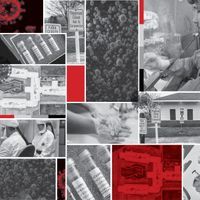Login
Subscribe404
Not Found
Is this what you were looking for?
tag breeding microbiology evolution disease medicine

The Inside Guide: The Gut Microbiome’s Role in Host Evolution
Catherine Offord | Jul 1, 2021 | 10+ min read
Bacteria that live in the digestive tracts of animals may influence the adaptive trajectories of their hosts.

A Pioneer of The Multiplex Frontier
Rashmi Shivni, Drug Discovery News | May 20, 2023 | 10 min read
George Church is at it again, this time using multiplex gene editing to create virus-proof cells, improve organ transplant success, and protect elephants.

Follow the Coronavirus Outbreak
The Scientist | Feb 20, 2020 | 10+ min read
Saliva tests screen staff and students at University of Illinois; Study ranks species most susceptible to SARS-CoV-2 infection; COVID-19 clinical trials test drugs that inhibit kinin system

Do Pathogens Gain Virulence as Hosts Become More Resistant?
Andrew F. Read and Peter J. Kerr | Oct 1, 2017 | 10+ min read
Emerging infections provide clues about how pathogens might evolve when farm animals are protected from infection.

Who Sleeps?
The Scientist and Jerome Siegel | Mar 1, 2016 | 10+ min read
Once believed to be unique to birds and mammals, sleep is found across the metazoan kingdom. Some animals, it seems, can’t live without it, though no one knows exactly why.

Some Cancers Become Contagious
Katarina Zimmer | Apr 1, 2019 | 10+ min read
So far, six animal species are known to carry transmissible, “parasitic” forms of cancer, but researchers are still mystified as to how cancer can become infectious.
How to Create a Successful Fish Tale?
A. J. S. Rayl | Aug 19, 2001 | 10+ min read
More than 80 percent of the planet's living organisms exist only in aquatic ecosystems. Some may harbor secrets to human origins, and clues, treatments--perhaps even cures--for human disease. Some are critical bioindicators that portend the health of the biosphere. Yet, overall, scientists know little about the biochemical processes of these life forms. The vast, rich knowledge within the oceans and freshwater systems on Earth remains virtually untapped, because in the world of biological resear
Feline Genome Research Advances
Myrna Watanabe | Jul 23, 2000 | 10 min read
©Wonderfile U.S.A. Corp. The cat could serve as a model for more than 200 human inborn genetic errors. The Canine Genome Project is big news--not as big as the Human Genome Project, but still "visible," reported on in magazines and newspapers. Ongoing research on the house cat's genome is "not so visible," says geneticist Marilyn Menotti-Raymond of the Laboratory of Genomic Diversity (LGD) of the National Cancer Institute (NCI) in Frederick, Md. But the feline research is more advanced and
60 Members Elected to NAS
Barry Palevitz | Jun 25, 2000 | 6 min read
Editor's Note: On May 2, the National Academy of Sciences announced the election of 60 new members and 15 foreign associates from nine countries in recognition of their distinguished and continuing achievements in original research. Nearly half of the new members are life scientists. In this article, The Scientist presents photographs of some of the new members and comments from a few of them on their careers and on past and current research. A full directory of NAS members can be found online a
AIDS Investigators Cautiously Applauding Recent Advances
Steven Benowitz | Sep 29, 1996 | 10+ min read
Discoveries announced at conference leave scientists feeling optimistic; yet their enthusiasm is tempered by several persistent concerns. AIDS researchers have many reasons to be encouraged. Studies show that treatments combining new and old drugs can control HIV levels in the blood. Moreover, many scientists and activists note, prevention efforts have helped reduce HIV infection rates. Yet the enthusiasm is tempered by several caveats. Drugs are expensive and have harsh side effects, leading